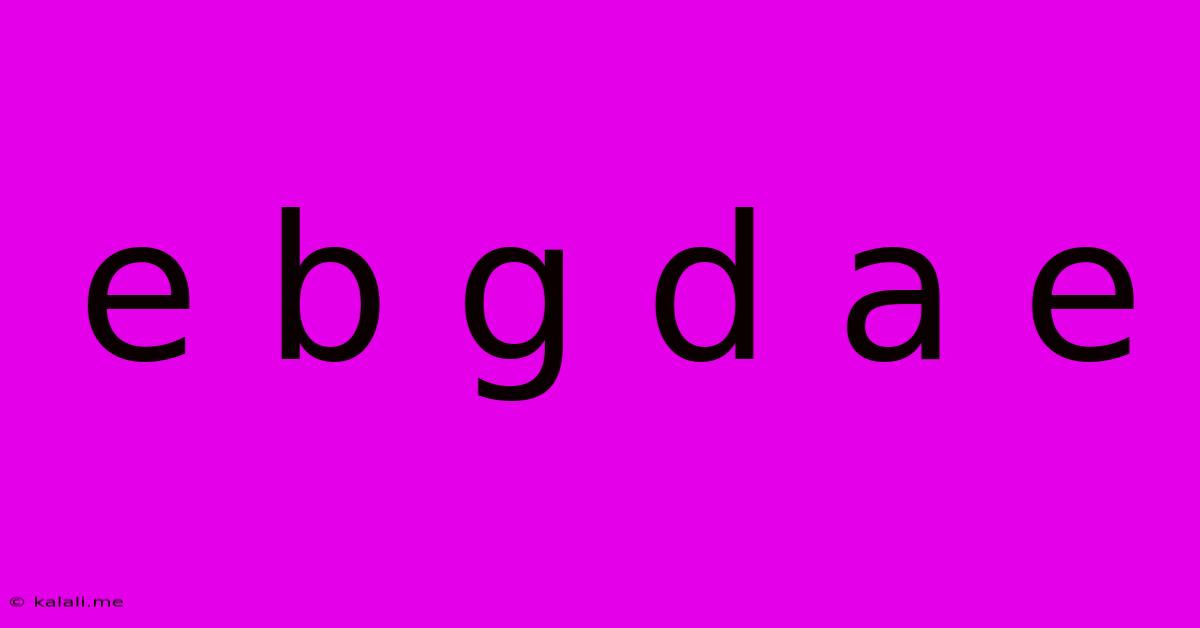E B G D A E
Kalali
May 25, 2025 · 3 min read

Table of Contents
Decoding the Mystery: E B G D A E – A Musical Journey Through Intervals and Chords
Meta Description: Unravel the musical secrets behind the note sequence E B G D A E. Explore its intervallic structure, potential chord progressions, and its place within musical theory. Discover how this seemingly simple sequence holds surprising depth.
The seemingly simple sequence of notes – E B G D A E – might appear innocuous at first glance. However, a closer examination reveals a fascinating interplay of intervals, potential chord progressions, and harmonic possibilities that unveil its rich musical tapestry. This sequence offers a great opportunity to delve into the fundamentals of music theory, exploring concepts like intervals, chords, and scales.
Understanding the Intervals
The key to understanding this sequence lies in analyzing the intervals between each note. Let's break it down:
- E to B: A major second (2 whole steps)
- B to G: A minor seventh (10 half steps) - This is a large interval and a key characteristic of the sequence.
- G to D: A perfect fifth (7 half steps) – A very common and consonant interval.
- D to A: A major third (4 half steps)
- A to E: A perfect fifth (7 half steps)
Notice the prominent use of perfect fifths (G-D and A-E). This interval is the cornerstone of many musical systems, known for its strong harmonic resonance. The inclusion of the minor seventh adds a touch of tension, hinting at a resolution that might be found in the final E.
Potential Chord Progressions
This sequence isn't just a random collection of notes; it suggests various chord progressions. While many interpretations are possible, some common possibilities include:
-
Bmaj7 - Em - Gmaj7 - Dmaj7 - Amaj7 - Emaj7: A possible progression built upon major seventh chords, flowing smoothly due to the presence of the perfect fifths. This progression creates a bright and major key feeling. The minor chord provides a momentary contrast.
-
Bm7 - Em - G7 - Dmaj7 - A7 - Emaj7: Here, we introduce minor seventh and dominant seventh chords (G7, A7), creating more harmonic interest and potentially leading to a stronger resolution on the final Emaj7. This creates a slightly bluesier or jazzier feel.
-
E minor pentatonic scale: The notes E, G, A, B, and D actually belong to the E minor pentatonic scale, lending a very characteristic pentatonic flavor to the sequence. This offers a different harmonic and melodic perspective.
The specific harmonic progression would largely depend on the context, the style of music, and the overall musical narrative the composer intends to build.
Exploring Further: Modes and Scales
This sequence can also be viewed within the context of various modes and scales. Its notes, while not fully encompassing a single scale, borrow elements from different scales, adding to its versatility. For instance, its relation to the E minor pentatonic scale, as mentioned above, allows for interpretations that lean towards a blues or folk-like feel. Further exploration might reveal its connections to other scales, enriching its harmonic possibilities.
Conclusion
The sequence E B G D A E, while seemingly simple, provides a rich playground for musical exploration. By analyzing its intervals, potential chord progressions, and its relationships to different scales and modes, composers and musicians can unearth its full potential, crafting music that ranges from bright and major to bluesy and soulful. Its study highlights the power of seemingly simple musical ideas to yield surprisingly complex and expressive results. The journey of understanding this sequence is a testament to the depth and beauty inherent within musical theory.
Latest Posts
Latest Posts
-
Wiring A Three Way Switch With A Dimmer
May 25, 2025
-
Stephen Shrees Volumes On Discrete And Continuous Time Models
May 25, 2025
-
Applescript Preview Save All Open Windows
May 25, 2025
-
Pilot Light Wont Stay Lit When I Release The Knob
May 25, 2025
-
How Do I Change From Text To Imessage
May 25, 2025
Related Post
Thank you for visiting our website which covers about E B G D A E . We hope the information provided has been useful to you. Feel free to contact us if you have any questions or need further assistance. See you next time and don't miss to bookmark.